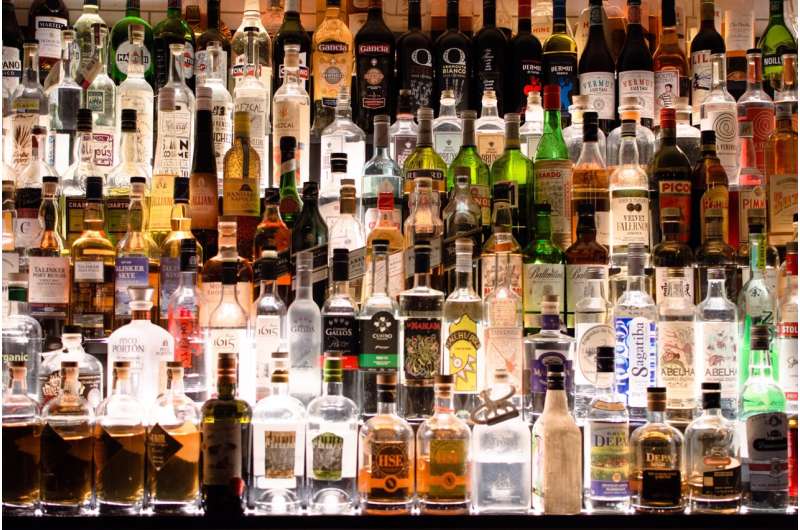This article has been reviewed according to Science X's editorial process and policies. Editors have highlighted the following attributes while ensuring the content's credibility:
fact-checked
peer-reviewed publication
trusted source
proofread
Increasing availability of non-alcoholic drinks may reduce amount of alcohol purchased online

Increasing the proportion of non-alcoholic drinks on sale in online supermarkets could reduce the amount of alcohol people purchase, suggests a study published today led by researchers at the University of Cambridge.
The team used a simulated supermarket that presented shoppers with varying proportions of alcoholic and non-alcoholic drinks and asked them to select drinks to purchase for their next online shop. They found that shoppers who were exposed to more non-alcoholic drinks selected and purchased fewer units of alcohol. The findings are published in PLOS Medicine.
Excessive alcohol consumption is a major risk factor for a number of diseases, including cancer, heart disease and stroke. Encouraging people to change their behavior could therefore have significant health benefits at both an individual and population level.
There is increasing evidence that people can be "nudged" toward reducing their alcohol consumption by making small adjustments to their environment. For example, scientists at Cambridge's Behavior and Health Research Unit have previously shown that serving wine in smaller glasses—even while keeping the amount of wine in the glasses the same—led to people consuming less alcohol.
A recent analysis found that reducing the proportion of unhealthy snacks available can reduce how much of these food products people consume, though the evidence included was limited in both quality and quantity. The Cambridge team wanted to see if a similar approach might work to nudge people towards consuming fewer alcoholic drinks.
The researchers recruited 737 adults living in England and Wales, all of whom regularly purchased alcohol online, to take part in the study. Of these, just over 600 completed the study and were included in the final analysis—60% were female and the average (mean) age was 38.
Participants selected drinks from 64 options in a simulated online supermarket designed to look and function like a real online supermarket. Options included a range of beers, ciders, alcohol-free beer and cider alternatives, and soft drinks.
Participants were randomly assigned to one of three groups, each of which was presented with a different proportion of alcoholic and non-alcoholic drinks. 25% of the drinks seen by Group 1 were non-alcoholic. For Group 2, this increased to 50%, and for Group 3 the proportion of non-alcoholic drinks seen rose to 75%.
Those exposed to the highest proportion of non-alcoholic drinks (Group 3) selected fewer alcohol units, 17.5 units, compared to 29.4 units in those exposed to the lowest proportion of non-alcoholic drinks (Group 1)—equivalent to a reduction of about 41%.
Participants were then asked to actually purchase the same drinks in an online supermarket, Tesco, the largest national supermarket in the U.K. About two-thirds of participants completed this second stage, with 422 participants going on to purchase drinks. The researchers point out that "cart abandonment"—where people do not purchase items they put in their shopping cart—is common in online shopping contexts.
The researchers found that amongst participants exposed to the highest proportion of non-alcoholic drinks, 52% of the drinks purchased were alcoholic, compared to 70% of drinks that were purchased by those exposed to the lowest proportion of non-alcoholic drinks.
Lead author Dr. Natasha Clarke said, "We created our simulated supermarket to be as close as possible to an actual online supermarket and found that increasing the proportion of non-alcoholic drinks that shoppers were exposed to made a meaningful difference to their alcohol selection. Though we'd need to confirm these findings using only a real online supermarket, they are very promising."
While the current market for alcohol-free beer, wine and spirits represents only a small share of the global alcohol industry, it is rapidly growing. For example, low and no-alcohol beer currently accounts for 3% of the total beer market, but this is forecast to increase by nearly 13% per year over the next 3 years and is the fastest growing drinks segment in the U.K.
Senior author Dr. Gareth Hollands said, "Supermarkets typically stock a wider range of alcoholic drinks than non-alcoholic alternatives aimed at adults, but this is slowly changing. Our results suggest that if non-alcoholic options were to become the majority instead, we might expect to see substantial reductions in alcohol purchasing."
Importantly, the overall number of drinks that participants selected and purchased remained similar between groups, suggesting that effects were a result of shifting people's choices. This implies overall drink sales and potentially revenues may be relatively unchanged, dependent on the pricing of non-alcoholic drinks.
Professor Dame Theresa Marteau, Director of the Behavior and Health Research Unit, said, "We all know that drinking too much alcohol is bad for us, but we're often unaware of how much we are influenced by the environment around us. Making changes to this environment—from exposing people to a greater proportion of healthier options through to changing the sizes of the utensils we eat and drink from—can help us cut down on potentially unhealthy habits. Even relatively small changes can make a difference both to individuals and at a population level."
Although some of the non-alcoholic drink options in the current study contained no sugar and were generally lower in calories than the alcoholic options—an average of 64 calories per non-alcoholic drink versus 233 calories per alcoholic drink—many soft drinks and alcohol-free alternatives still contain large amounts of sugar and calories. The researchers argue that, given the health risks associated with sugary drink consumption, continued regulation and policies to reduce sugar content and consumption from both alcoholic and non-alcoholic drinks is needed to mitigate these risks.
More information: Clarke, N et al., Impact on alcohol selection and online purchasing of changing the proportion of available non-alcoholic versus alcoholic drinks: A randomised controlled trial, PLOS Medicine (2023). DOI: 10.1371/journal.pmed.1004193




















